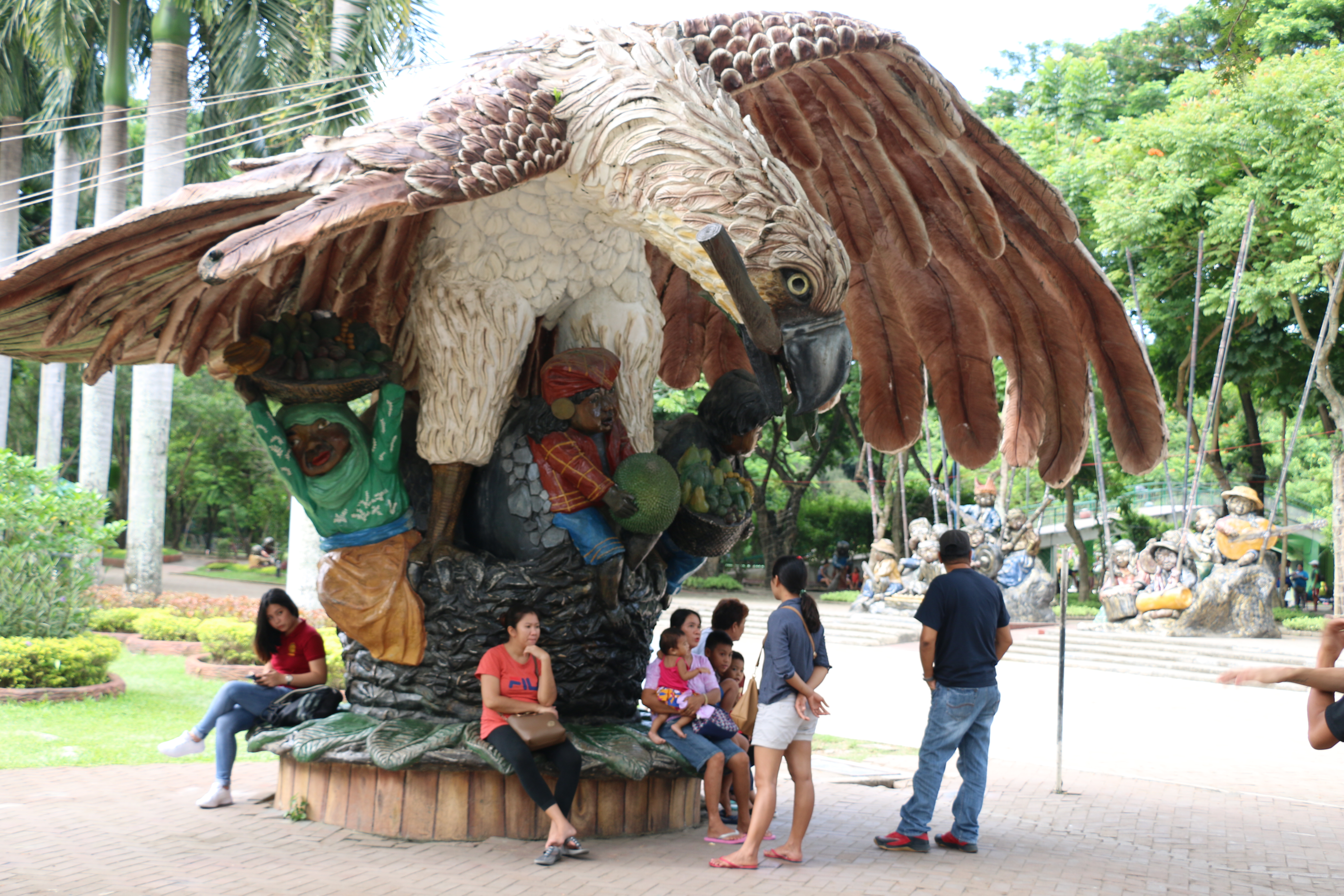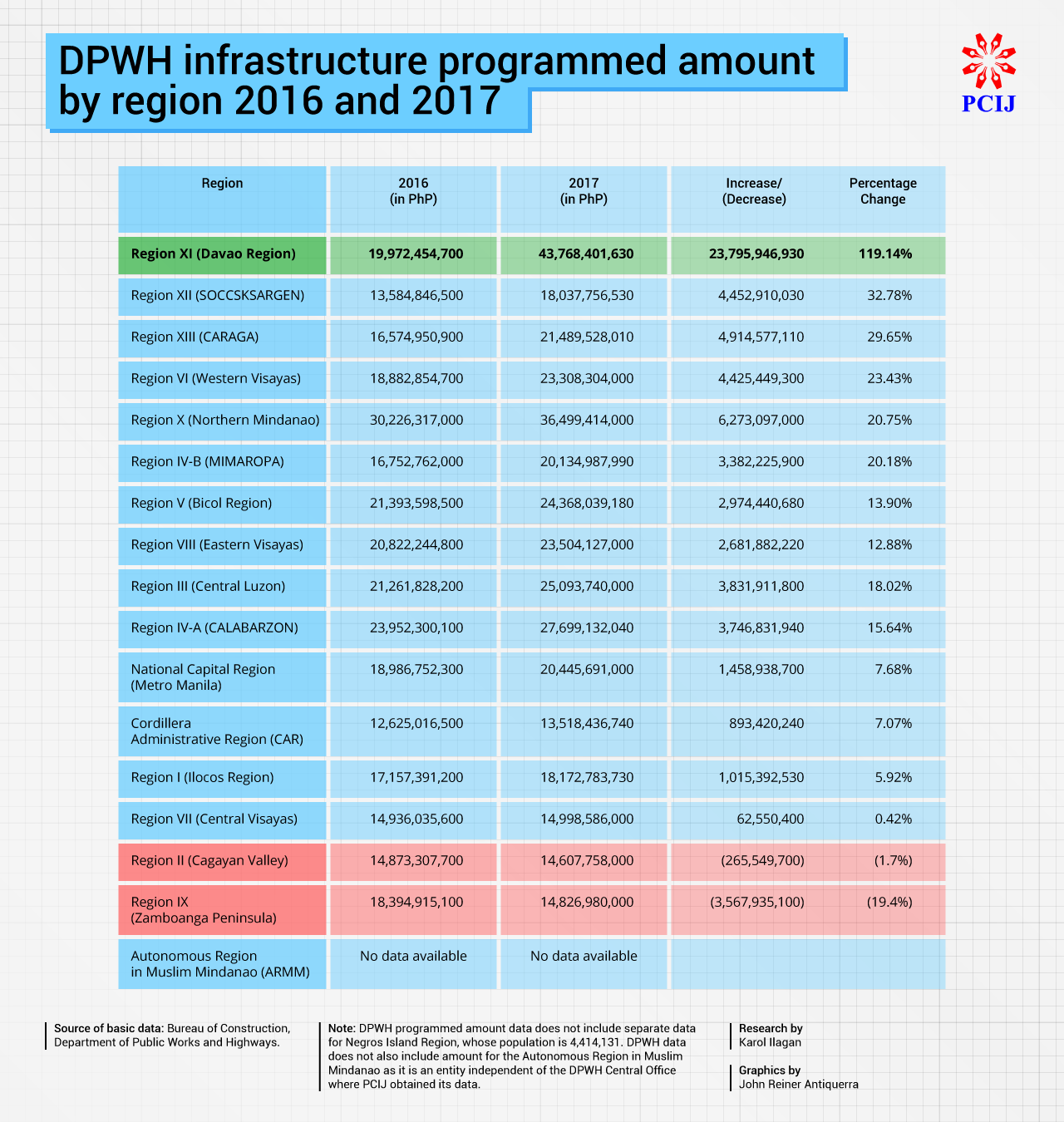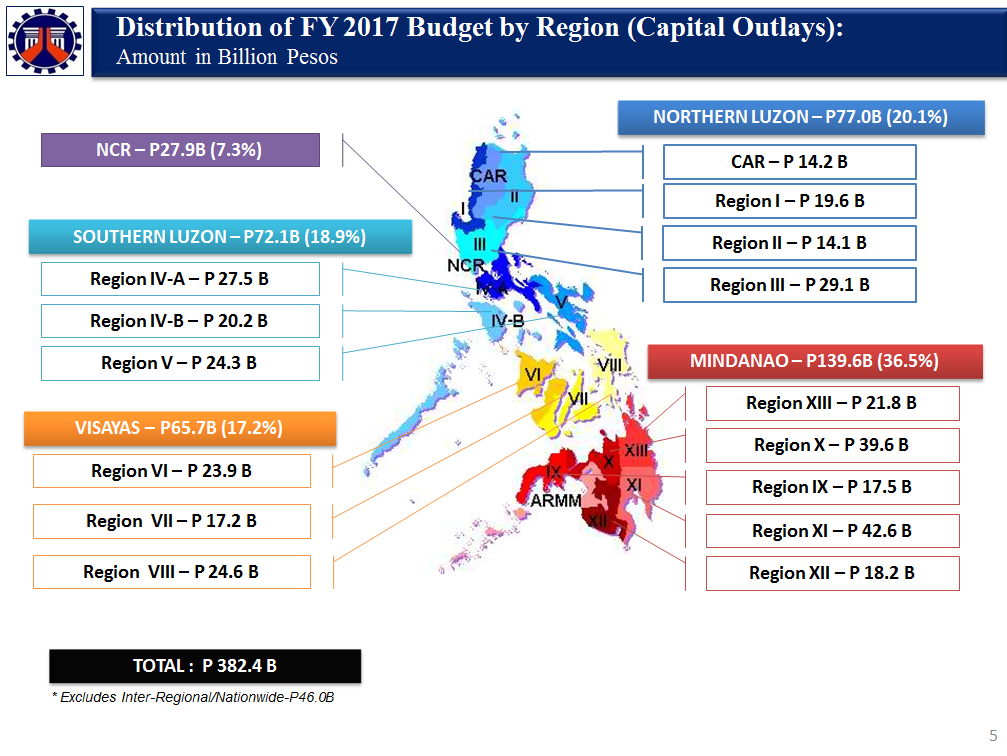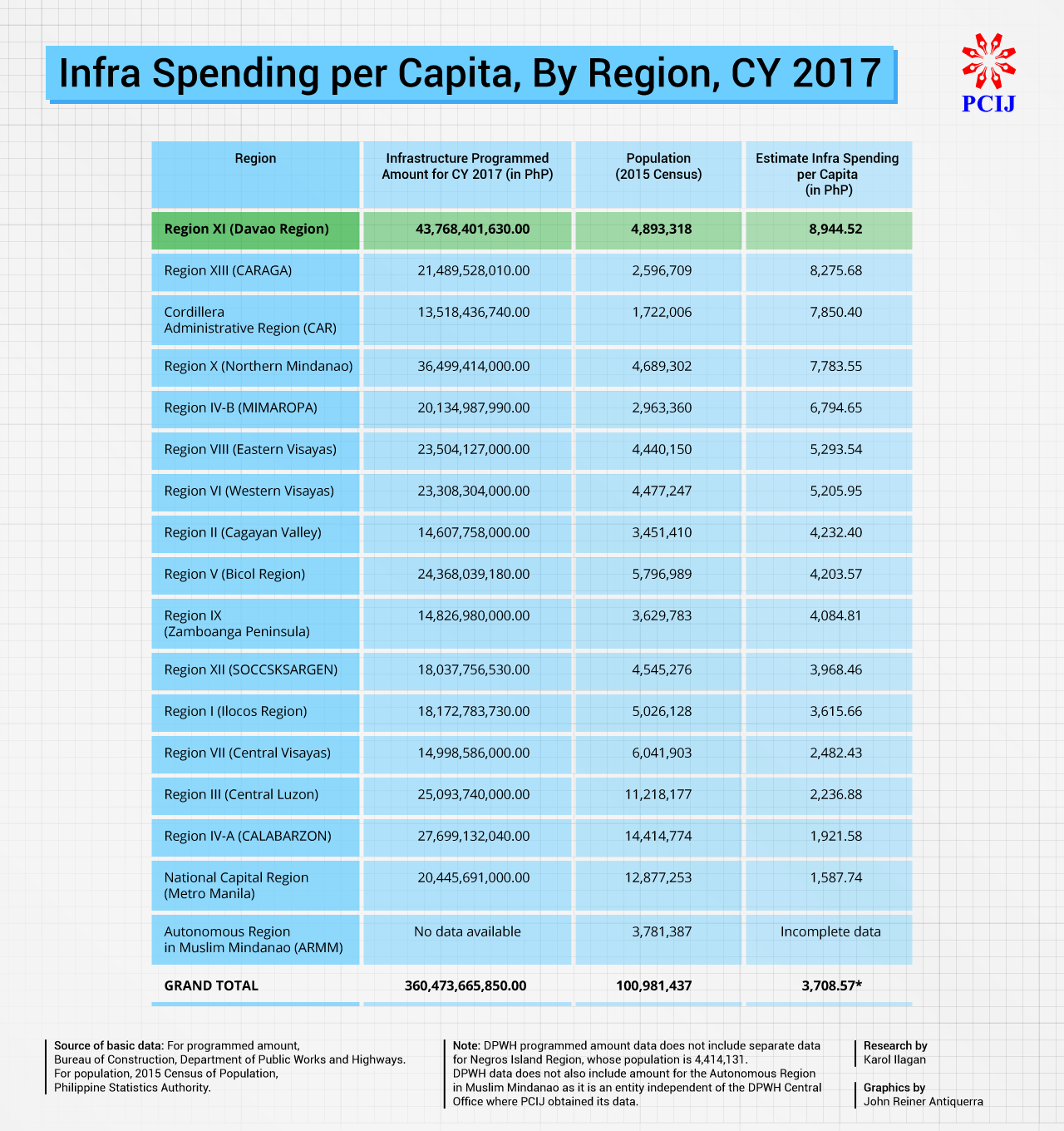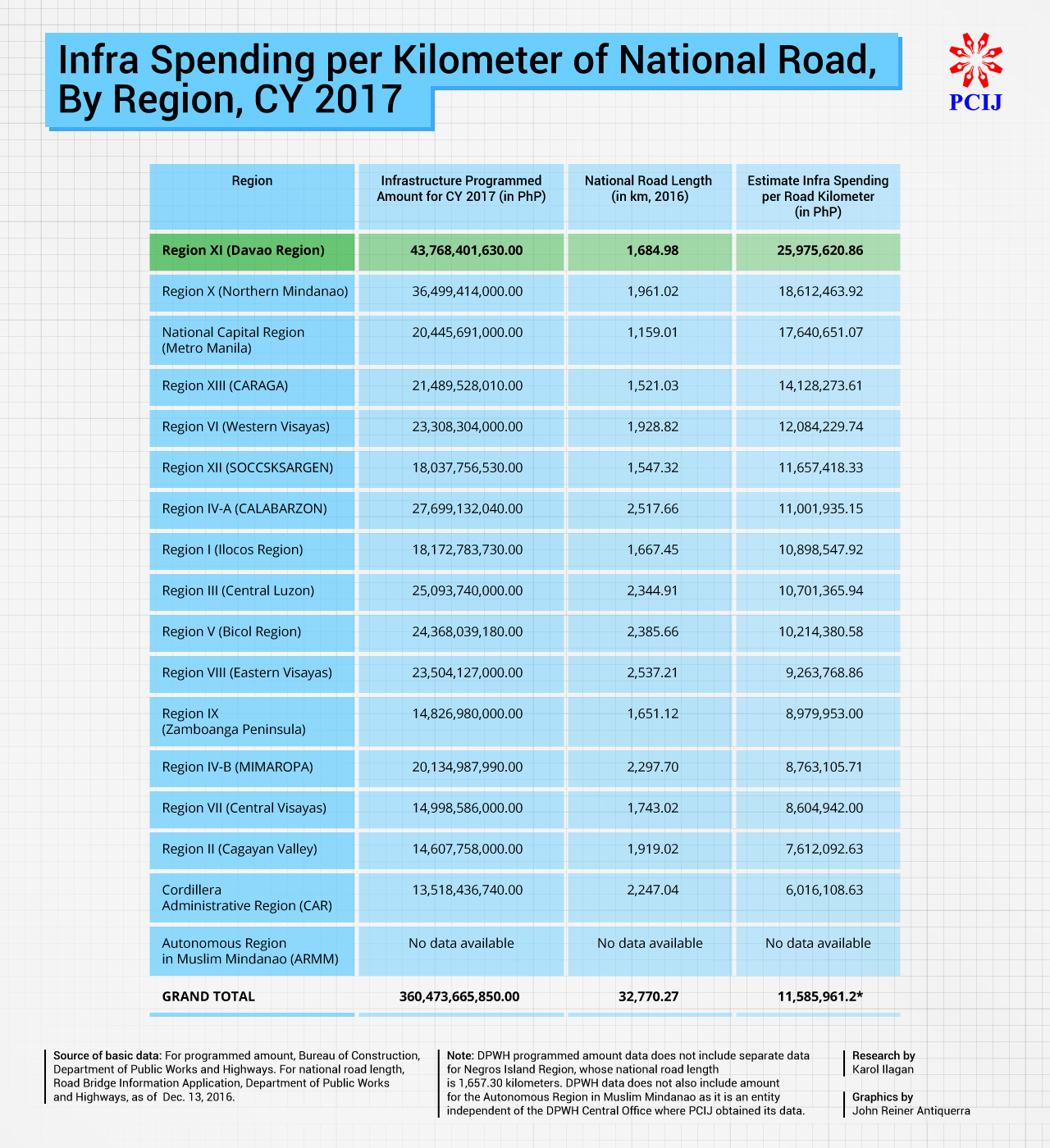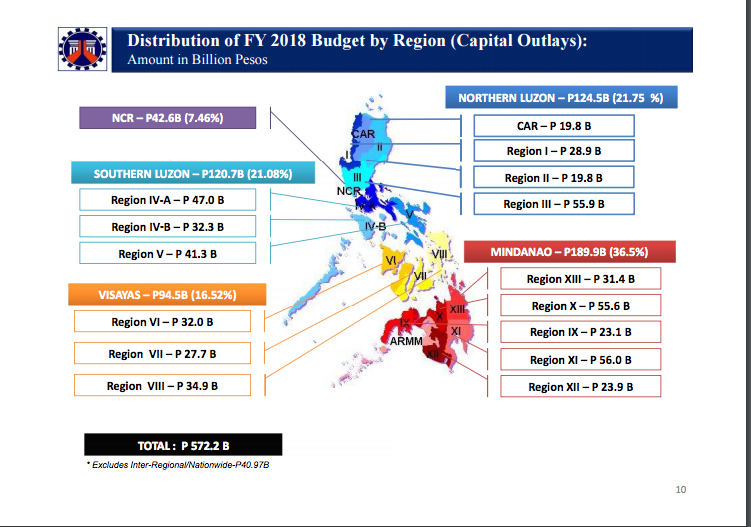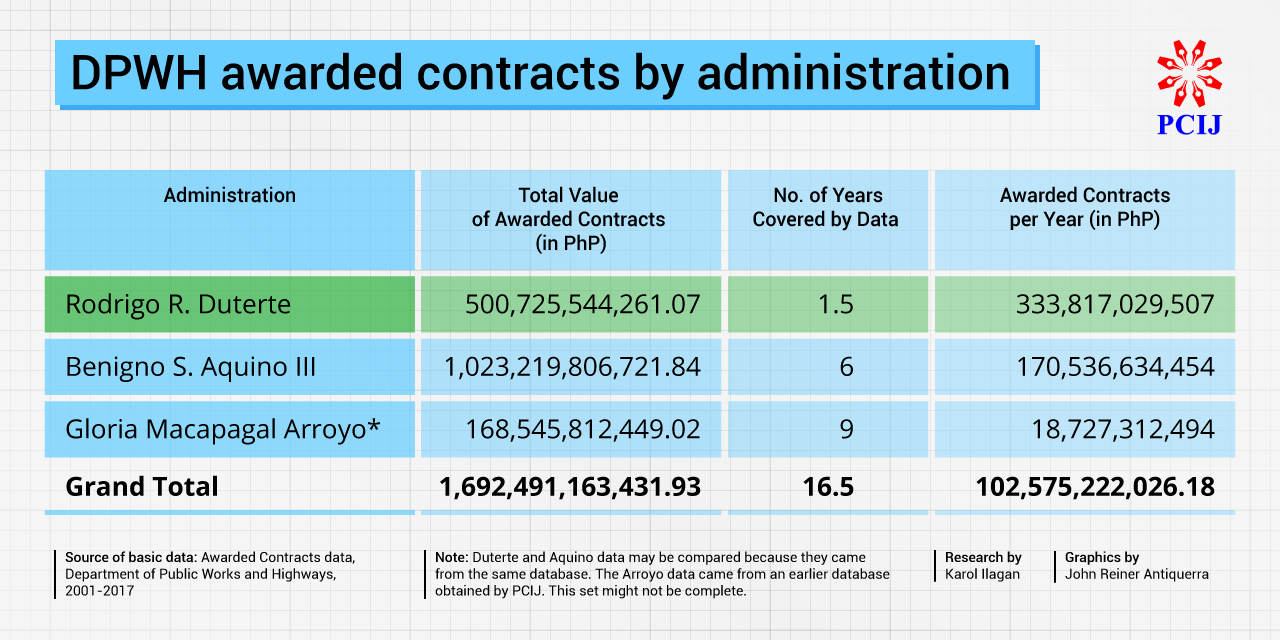IT’S AS GOOD as it gets for Davao Region, home and bailiwick of President Rodrigo R. Duterte.
And by the government’s own data, it’s as bad as it gets for many other regions of the country in terms of the spread of monies for civil-works projects, although a few have also managed to receive slight boosts.
There seems to be great promise though that this year, several regions have started to get more blessings in terms of infrastructure funds — apparently because there is more money to pass around from public funds, loans, and grants.
The 2018 budget for capital outlay of the Department of Public Works and Highways (DPWH), for distribution among the 16 regions (excluding the Autonomous Region in Muslim Mindanao) increased by 44.94 percent to PhP613.1 billion, including PhP40.9 billion “for inter-regional/nationwide projects.”
In 2017, the agency’s capital outlay to be distributed among the 16 regions totaled PhP423 billion, including Ph40.6 billion for “inter-regional/nationwide projects.”
But from 2016 to 2017 under Duterte, two regions suffered budget cuts, three got negligible increases, and the rest just a billion to at most six billion pesos more in civil-works contracts.
Unfinished: PhP24.5B
In contrast, Davao Region, the most blessed hands down, got PhP24 billion more. Its civil-works budget of PhP19.97 billion in 2016 rose by 119 percent, or more than doubled to PhP43.77 billion, in 2017.
As if this were not enough, this year the region’s civil-works programs got a super uptick again: PhP56 billion, or another 27-percent increase in capital outlay under DPWH’s 2018 Infrastructure Program.
By all indications, Duterte has vested Davao the most-favored region status with a 146-percent total increase in its civil-works budget in the last two years.
The 2016 national budget was the last proposed and passed under former President Benigno S. Aquino III while the 2017 national budget, the first proposed and passed under Duterte.
But by DPWH’s own data as of April 30, 2018, at least 295 unfinished projects account for more than half or PhP24.5 billion of Davao Region’s PhP43.77-billion civil works budget in 2017.
Davao Region consists of the provinces of Compostela Valley, Davao del Norte, Davao Oriental, Davao del Sur, and Davao Occidental, and Davao City, which serves as regional center.
Favored region, too
To be sure, Aquino and before him, former President Gloria Macapagal Arroyo, had also clearly taken care of their similar home region and bailiwick of Central Luzon. Duterte’s immediate predecessor belongs to the Aquino and Cojuangco clans of Tarlac province, while Arroyo hails from Pampanga province.
Central Luzon was on top from 2010 to 2012, No. 2 in 2013, then No. 1 again in 2015, in its DPWH allocations under Aquino. The 2010 national budget, though, was the last proposed and passed under the Arroyo administration.
Western Visayas was on top in 2014, and Northern Mindanao in 2016. CALABARZON meanwhile has consistently been in the top three from 2010 to 2017.
But it was only in 2017 under Duterte that Davao shot up to the top. Davao Region, from 2010 to 2016, had
Yet in its big comeback under Duterte, Davao Region’s 119-percent increase in its civil-works budget from 2016 to 2017 is exceedingly skewed compared with the just 86.8-percent composite increase in the civil-works budget of Metro Manila and six Luzon island regions — Cordillera Administrative Region, Ilocos Region, Central Luzon, CALABARZON, MIMAROPA, and Bicol Region—for the same period.
A seventh Luzon region, Cagayan Valley, even suffered a budget cut of 1.7 percent.
In all, Luzon’s seven regions are home to a total of 38,795,855 people, while Metro Manila hosts another12,877,253 residents, according to the 2015 national census of population.
Visayas, Mindanao
Yet again, compared with the civil-works budgets of the three regions of the Visayas, the 119-percent increase in Davao Region’s civil-works budget seems incredibly unequal.
The three Visayas regions — Western Visayas Visayas, Central Visayas, and Eastern Visayas — altogether got just 36.7 percent more in their combined civil-works budget in the first two years of Duterte.
Then again, the combined population of the three Visayas island regions comes up to 14,959,300, as of 2015 official data.
Three other Mindanao regions meanwhile received a composite increase of 83.13 percent in their civil-works budget, notably SOCCSKSARGEN (32.78-percent increase), Northern Mindanao (20.7-percent increase), and CARAGA (29.65-percent increase).
But then a fourth Mindanao Region, Zamboanga Peninsula, recorded a 19.4-percent drop in its civil-works budget. No data could be obtained from the DPWH for the Autonomous Region in Muslim Mindanao or ARMM.
Interestingly, while the Mindanao regions as a group got twice more money for civil-works projects under Duterte, the island accounts for only half the combined population of Luzon’s seven regions.
Apart from ARMM’s population of 3,781,387, the five regions of Mindanao account for a combined population of only 20,354,388, or just half of Luzon island’s total.
Monies and regions
The smallest budget increase in 2017 for civil-works projects was given to Central Visayas: a mere 0.42 percent. The National Capital Region and the Cordillera Administrative Region fared a little better, but still paled in comparison with the rest; both saw their respective civil-works project budgets rise by just seven percent more from 2016 to 2017.
This is how the civil-works budgets of the regions across the country looked like from 2016 to 2017, in cold cash:
The Regions of Luzon:
• National Capital Region, PhP18,986,752,300 to PhP20,445,691,000, up 7 percent
• Cordillera Administrative Region, PhP12,625,016,500 toPhP13,518,436,740, up 7 percent;
• Ilocos Region, PhP17,157,391,200 to PhP18,172,783,730, up 5.9 percent;
• Cagayan Valley, PhP14,873,307,700 to PhP14,607,758,000, down 1.7 percent;
• Central Luzon, PhP21,261,828,200 to PhP25,093,740,000, up 18 percent;
• CALABARZON, PhP23,952,300,100to PhP27,699,132,040, up 15 percent;
• MIMAROPA, PhP16,752,762,000 to PhP20,134,987,990, up 20 percent; and
• Bicol Region PhP21,393,598,500 to PhP24,368,039,180, up 13.9 percent.
The Regions of the Visayas:
• Western Visayas. PhP18,882,854,700 to PhP23,308,304,000, up 23.4 percent;
• Central Visayas. PhP14,936,035,600 to PhP14,998,586,000, up 0.42 percent; and
• Eastern Visayas, PhP20,822,244,800 to PhP23,504,127,000, up 12.88 percent.
The Regions of Mindanao:
• Zamboanga Peninsula, PhP18,394,915,100 to PhP14,826,980,000, down 19.4 percent;
• Northern Mindanao, PhP 30,226,317,000 to PhP36,499,414,000, up 20.7 percent;
• Davao Region, PhP19,972,454,700 to PhP43,768,401,630, up 119 percent;
• SOCCSKSARGEN, PhP13,584,846,500 to PhP18,037,756,530., up 32.78 percent;
• CARAGA, PhP16,574,950,900 to PhP21,489,528,010, up 29.65 percent; and
• Autonomous Region in Muslim Mindanao, No data available.
Per capita values
Analyzed for per capita spending, by population, the numbers suggest that more funds have been allocated for people in some regions that for others, and yet again, Davao Region emerges as the big winner.
For instance, DPWH allocated PhP8,944.52 per capita in Davao Region for its population of 4,893,318 as of the 2015 National Census.
This implies an unusual scenario, however: That for every resident of Davao Region, DPWH is spending twice more money than the national per capita per population cost of civil-works projects.
Here’s how the numbers fall for the Philippines: The programmed amount for infrastructure amounted to PhP360,473,665,850 in 2017; by the 2015 national census, the national population has reached 100,981,437. This then results in an estimated infra spending of only PhP3,708.57 per Filipino in 2017.
Apart from Davao, outer regions such as CARAGA, Cordillera Administrative Region, Northern Mindanao, and MIMAROPA received more money per person.
The most populous regions, CALABARZON, Metro Manila, and Central Luzon, got the lowest per capita spending.
Per road kilometer
Computing for infrastructure spending per national road kilometer is another mode of inquiry.
The data show that in 2017, DPWH allocated PhP25.9 million per road kilometer in Davao for its 1,684.98 kilometers of national roads.
Apart from Davao Region, Northern Mindanao, Metro Manila, CARAGA, and Western Visayas, got higher per road-kilometer spending. Cagayan Valley and CAR got lower.
Yet again, Davao Region’s per capita infra spending for 2017 surpassed the average national spending per capita per kilometer of national road by more than twice more.
Because it got PhP43.77 billion in civil works budget for 2017, and has only 1,684.98 kilometers of national roads, Davao Region’s infra spending per kilometer of national road comes up to PhP25,975,620.86.
This is more than double the national per capital per kilometer of road, for all Philippines, of only PhP11,585,961.28. This figure derives from the infrastructure budget of PhP360,473,665,850 in 2017, computed against a total of 32,770.27 kilometers of national roads.
2018 allocations
This year, under its PhP613.1-billion budget for infrastructure (capital outlays), DPWH said the allocations for the regions follow:
• National Capital Region (Metro Manila), PhP42.6 billion;
• Cordillera Administrative Region (CAR), PhP19.8 billion;
• Region I (Ilocos Region), PhP28.9 billion;
• Region II (Cagayan Valley), PhP19.8 billion;
• Region III (Central Luzon), PhP55.9 billion;
• Region IV-A (CALABARZON), PhP47 billion;
• Region IV-B (MIMAROPA), PhP32.3 billion;
• Region V (Bicol Region), PhP41.3 billion;
• Region VI (Western Visayas), PhP32 billion;
• Region VII (Central Visayas), PhP27.7 billion;
• Region VIII (Eastern Visayas), PhP34.9 billion;
• Region IX (Zamboanga Peninsula), PhP23.1 billion; and
• Region X (Northern Mindanao), PhP55.6 billion;
• Region XI (Davao Region), PhP56 billion;
• Region XII (SOCCSKSARGEN), PhP23.9 billion;
• Region XIII (CARAGA), Php31.4 billion;
• Inter-regional/nationwide projects, PhP40.9 billion.
In this spread of public works monies, DPWH said that Northern Luzon has been allotted 21.75 percent of the total, Southern Luzon 21.08 percent, the Visayas 16.52 percent, and NCR 7.46 percent. Mindanao gets a bigger 36.5 percent.
By the amount of infrastructure budgets they will get from DPWH this year, this is how the regions rank from highest to lowest: Davao Region, Central Luzon, Northern Mindanao, CALABARZON, NCR, Bicol Region, Eastern Visayas, MIMAROPA, CARAGA, Ilocos Region, Central Visayas, SOCCSKSARGEN, Zamboanga Peninsula, and Cagayan Valley and Cordillera Administrative Region.
Value and volume
Under the Duterte administration, DPWH has awarded an estimated 19,810 projects per year since July 2016. This is more than the average number of DPWH projects awarded during the Aquino administration of 17,042 contracts per year. The data covered Aquino’s full six years in office, while the data for Duterte covered only 1.5 years, or from July 2016 to December 2017.
The Duterte and Aquino data may be compared because they came from the same database. The data for the nine-year rule of President Gloria Macapagal Arroyo from 2000 to June 2010 came from earlier database that PCIJ obtained from DPWH. This second set might not be complete, however. — With reporting and research by Karol Ilagan, PCIJ, September 2018
——————————————————————————————————————————————————————————————–
Check out, PCIJ’s reports on “Build, Build, Build” hits chokepoint”
* DPWH under Duterte: Corruption, politics, slippage mar many projects
* Top 10 contractors under Duterte run record of fraud, delays, blacklisting
* Contractors: Candor from a few, thunderous silence from the rest
* Vetting contractors
* Davao Region most favored; others get cuts, token hike in infra budgets
* Firms of Bong Go kin, top contractors: Many JVs, delayed projects in Davao
* Did he help Dad, half-brod get deals? Unfair! Prove it, I will resign – Bong Go
